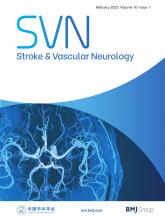The bifurcation regions of intracranial and extracranial arteries are common sites for atherosclerosis, predisposing to ischaemic stroke.1 Previous studies have shown that the unique haemodynamics at the bifurcation may lead to alterations in genes and proteins in this region.2 Elastin is closely associated with the progression of atherosclerosis.3 However, under physiological conditions, the expression and distribution of elastin in bifurcation regions have not yet been elucidated. Mice are the most frequently used animal model for studying atherosclerosis. This study focuses on carotid bifurcation, optimising the iDISCO (immunolabeling-enabled three-dimensional imaging of solvent-cleared organs) technique for whole tissue clearing and staining of the carotid artery in mice.4 These techniques, along with fluorescence micro-optical sectioning tomography (FMOST) technology, have also been used in studies on ischaemic stroke and kidney diseases,4 highlighting their potential for broader applications due to their high precision and three-dimensional imaging capabilities.5 Using FMOST technology in vitro, we have made a detailed visualisation of a U-shaped expression pattern of elastin at bifurcation regions for the first time. Specifically, elastin expression is found to be lowest at the bifurcation itself compared with the regions adjacent to or proximal to the bifurcation (figures 1A,B). Furthermore, we observed disorganised arrangement of elastic fibres within the bifurcation zone (figures 1C,D). These findings provide important evidence linking elastic fibres to the pathogenesis of atherosclerosis at bifurcations and suggest the potential for more precise local therapies for atherosclerosis, which could significantly advance precision medicine and reduce the potential side effects on normal tissues.
Visualisation of U-Shaped elastin distribution and disorganised fibre arrangement at carotid bifurcations. (A) Immunofluorescent staining of carotid artery elastin using whole-tissue clearing technology, followed by imaging with fluorescence micro-optical sectioning tomography technology. (B) Sharpened image of A (diagram of elastin fibre arrangement patterns in different regions within the blue and green boxes). (C) High-resolution image of carotid tissue within the blue boxed area in B. (D) High-resolution image of carotid tissue within the green boxed area in B.
Data availability statement
The data that support the findings of this study are available from the corresponding author, YX, upon reasonable request.
Ethics statements
Patient consent for publication
Ethics approval
This study involves animals and was approved by the Ethics Committee of the First Affiliated Hospital of Zhengzhou University (2020-KY-0067-001).
Footnotes
SL and PL are joint first authors.
Contributors SL and PL drafted and edited the manuscript. YX provided funding and designed the study. The experimental procedures were meticulously carried out by SL and XW. ZX and YX revised the article. All authors have read and approved the final manuscript.
Funding This work was supported by the National Natural Science Foundation of China grant number 81530037 to Yuming Xu, 82401556 to Shen Li and 82301320 to Peipei Li.
Competing interests None declared.
Provenance and peer review Not commissioned; externally peer reviewed.
This is an open access article distributed in accordance with the Creative Commons Attribution Non Commercial (CC BY-NC 4.0) license, which permits others to distribute, remix, adapt, build upon this work non-commercially, and license their derivative works on different terms, provided the original work is properly cited, appropriate credit is given, any changes made indicated, and the use is non-commercial. See: http://creativecommons.org/licenses/by-nc/4.0/.







